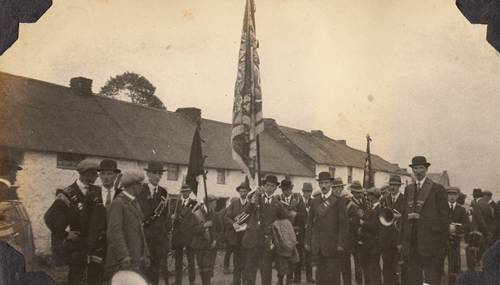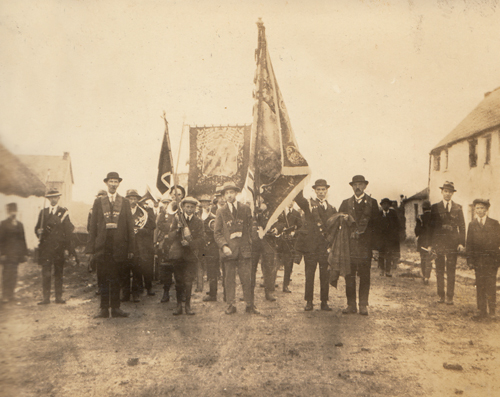This series of photographs shows the annual parade of the Royal Black Preceptory (R.B.P) in Cootehill, County Cavan in 1920. Also known as the Royal Black Institute, it is a Protestant fraternal society (non-Protestants cannot become members unless they agree to adhere to the principles of Orangeism and convert). To join the R.B.P. one must already be a member of the Orange Order. 1931 was the last time that large parades took place in counties Monaghan and Cavan.
The photographs show the group gathering on the outskirts of the town complete with banners and flags. Some wear sashes adorned with what appear to be military medals. The band is brass rather than the more usual flute or pipe type. You can see some interesting examples of R.B.P. tokens and regalia here and here.
This photograph was taken whilst the Irish War of Independence was underway although casualties in the county of Cavan were not high. The state of Northern Ireland which was to be created in 1921 included only six of the nine counties of the province of Ulster. Cavan, Monaghan and Donegal were excluded and formed part of the Irish Free State. The only major Orange Order march in the Republic of Ireland takes place every July in the village of Rossnowlagh, near Ballyshannon, in the south of County Donegal.
The images come from a fascinating album which includes joyful snapshots of modern young women bathing on Killiney beach. It also shows a branch of the Whitfield family who emigrated from Cavan to Canada in the late 1920s and a pair of Cavan-born sisters who worked in a Kansas, Missouri hospital during the smallpox epidemic in 1920. The album represents the intersection of the political and the private and shows a mix of both urban and rural life.


